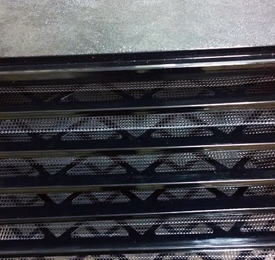A food dehydrator is a device that removes moisture from food to aid in its preservation. A food dehydrator uses a heat source and air flow to reduce the water content of foods. The water content of food is usually very high, typically 80% to 95% for various fruits and vegetables and 50% to 75% for various meats. Removing moisture from food restrains various bacteria from growing and spoiling food. Further, removing moisture from food reduces the weight of the food. Thus, food dehydrators are used to preserve and extend the shelf life of various foods. In addition removing water causes the flavors of the food to become more concentrated. Many culinary techniques make use of food dehydrators.
Most foods are dehydrated at temperatures of 130 °F, or 54 °C, although meats being made into jerky should be dehydrated at a higher temperature of 155 °F, or 68 °C, or preheated to those temperature levels, to guard against pathogens that may be in the meat. The key to successful food dehydration is the application of a constant temperature and adequate air flow. Too high a temperature can cause food to be hardened, that is food that is hard and dry on the outside but moist on the inside, and therefore vulnerable to spoiling on the inside.
Key to Optimal Dehydration
The major key in optimal dehydration is to remove moisture as quickly as possible at a temperature that does not seriously affect the flavor, texture and color of the food. If the temperature is too low in the beginning, bacteria may survive and grow before the food is adequately dried. If the temperature is too high and the humidity too low, the food may harden on the surface. This makes it more difficult for moisture to escape and the food does not dry properly. A “trial and error” approach often is needed to decide which techniques work best for the dehydrator and food type you are using.
Notes on Dehydrators
The The Excalibur® line and Nesco lines are two of the most popular type of food dehydrators. The Excalibur line of dehydrators contain a set of square plastic mesh racks on which the prepared fresh material is placed. These racks slide into the drying chamber where a continuous stream of warm air removes the water. Dehydrators like Nesco / American Harvest ®, use stackable trays to hold the produce being dried. Once again, a fan circulates heated air throughout the unit. These are the two most popular brands of dryers available and both do an excellent job. .
Health Benefits of Dried Fruits
A 2005 study in Journal of the American College of Nutrition(see below: Dried fruits: excellent in vitro and in vivo antioxidants) revealed that antioxidants in dried cranberries, grapes, and plums are twice as potent as those in the fresh fruits.
Results of Study: "Dates have the highest concentration of poly phenols among the dried fruits. Figs and dried plums have the best nutrient score among the dried fruits, and dates among the fresh fruits. Processing to produce the dried fruit significantly decreases the phenols in the fruits on a dry weight basis. Compared with vitamins C and E, dried fruits have superior quality antioxidants with figs and dried plums being the best. Fig antioxidants can enrich lipoproteins in plasma and protect them from subsequent oxidation. Figs produced a significant increase in plasma antioxidant capacity for 4 hours after consumption, and overcome the oxidative stress of consuming high fructose corn syrup in a carbonated soft drink." |
Source:
Dried fruits: excellent in vitro and in vivo antioxidants. J Am Coll Nutr. 2005 Feb;24(1):44-50.
|
 |
Shown to left is a dehydrated zucchini blossom that was initially frozen during summer. Spreading the blossom out on the mesh rack and dehydrating for 30 minutes resulted in a very flavorful, crispy garnish. It is important to turn the flower over once before it begins to stick to the surface.
|
Readings and References
Drying Vegetables --Colorado State University

